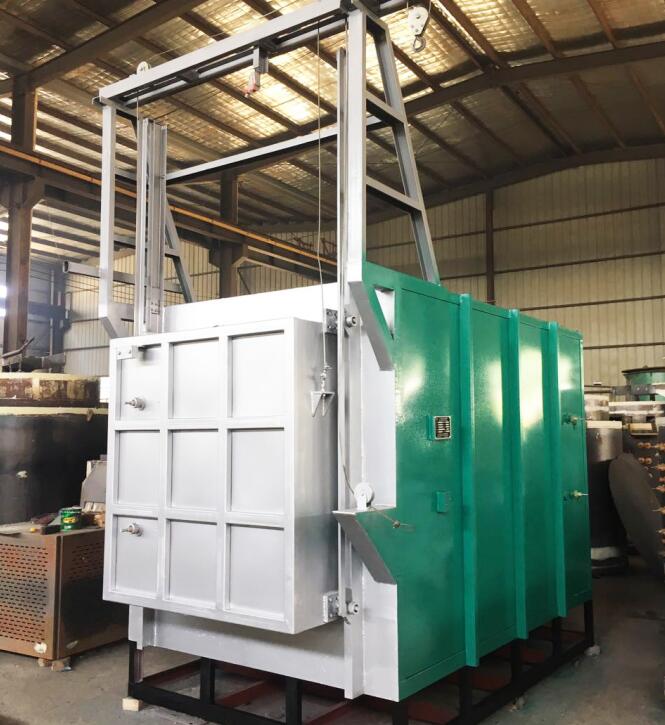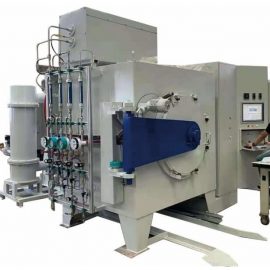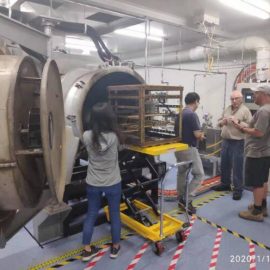High Temperature Fastener Heat Treatment Process
In this paper, the effect of heat treatment process on the microstructure and mechanical properties of 2Cr12NiMoWV steel was studied. The results show that when the steel is quenched at 1055-1070 ℃ and tempered at 700-710 ℃, good strengthening and toughening effect can be obtained. And on this basis, the heat treatment process specification of this steel is determined when it is used to manufacture high temperature fastening bolts for steam turbines.
2Cr12NiMoWV steel is a 12 % Cr type martensitic stainless heat-resistant steel, which is mainly used in the manufacture of high-temperature fasteners for large steam turbines. With the development of large steam turbines and their manufacturing technology, the amount of this steel in China is increasing. However, so far, there are few research reports on the influence of heat treatment system on the microstructure and properties of this steel, which brings a lot of inconvenience to the practical application of this steel. Therefore, the effect of different heat treatment parameters on the microstructure and room temperature mechanical properties (mainly hardness and impact toughness) of 2Cr12NiMoWV steel was studied in this paper. On this basis, the heat treatment process for the high temperature fastening bolts of steam turbines made of this steel is optimized.
A. Test materials and test methods
1.1 Test material
The test material is taken from the retired steam turbine bolt of a power plant, and its chemical composition (%) is: 0.24 C, 12.22 Cr, 0.62 Ni, 0.93 Mo, 1.25 W, 0.30 V, 0.20 Si, 0.64 Mn, 0.016 P, 0.010 S.
1.2 Test method
First, the test steel was annealed. The annealing process was heating at 870 °C for 3 h, cooling to 700 °C for 3 h at 20 °C/h, and then furnace cooling to 500 °C for air cooling. The annealed structure (Fig. 1) is that granular carbides and a certain amount of grain boundary carbides are distributed on the ferrite matrix. The annealed materials were processed into impact specimen blanks, which were subsequently quenched and tempered at different temperatures, and finally ground and wire-cut into standard Charpy impact specimens of 10 mm × 10 mm × 55 mm.
1. Annealing the tissue
A 4 kW high-temperature box-type electric furnace was used for quenching heating, and different quenching heating temperatures such as 950°C, 980°C, 1010°C, 1040°C, 1055°C, 1070°C, 1100°C, 1130°C, and 1160°C were selected for testing. The quenching heating time of each sample was 4 min/mm, and the oil was cooled after being released from the furnace. Tempering was carried out in a 5 kW multi-purpose furnace. Three tempering temperatures of 650 °C, 680 °C, and 710 °C were selected. The tempering time was 6 h, and the furnace was air-cooled.
The room temperature impact test was carried out on the samples after different heat treatments to determine the impact toughness value. Fracture analysis, metallographic analysis and hardness measurements were performed using the punched specimens. The etchant used in the metallographic analysis was an aqueous solution of ferric chloride and nitric acid. The determination of the austenite grain size is carried out according to the Hilliard method, and the corrosive agent used is a saturated aqueous picric acid solution plus a small amount of sodium alkyl benzene sulfonate.
2. Test results and analysis
2.1 The effect of quenching temperature on austenite grain size
As the quenching temperature increases, the austenite grains grow. When the temperature is lower than 1070°C, the tendency of grain growth is small, and when the temperature is higher than 1070°C, the grain growth rate is accelerated. During the quenching and heating process, the number of undissolved carbide phases directly affects the grain size of austenite, and the more the number of undissolved carbides, the smaller the grain size of austenite. Therefore, when the quenching temperature reaches 1070 ℃, most of the carbides in the original structure have been dissolved into the austenite, so that the obstacles hindering the grain boundary migration are greatly reduced, and the growth rate of austenite is accelerated.
2.2 The effect of quenching temperature on hardness and impact toughness
When tempering at 680°C and 710°C, at the same tempering temperature, the hardness increases continuously as the quenching heating temperature increases. This is because as the heating temperature increases, the amount of alloy carbides dissolved into austenite increases, so that the degree of alloying of austenite and the subsequently obtained martensite increases, thereby improving the tempering resistance of martensite. . The effect of quenching temperature on impact toughness is complex. With the increase of quenching temperature, the impact toughness increases. When the quenching temperature exceeds 1040℃, the impact toughness increases significantly; under the tempering condition of 710℃, the impact toughness increases when quenched at 1055℃~1070℃. When the quenching temperature exceeds 1100℃, the impact toughness decreases with the increase of the quenching temperature.
2.3 Effect of tempering temperature on hardness and impact toughness
In the temperature range of 650-710 ℃, under the same quenching temperature, with the increase of tempering temperature, the impact toughness increases and the hardness decreases. When the tempering temperature is higher than 680 ℃, the increase of impact toughness and the decrease of hardness increase obviously, indicating that the rate of tempering transformation is obviously accelerated above 680 ℃. Therefore, for 2Cr12NiMoWV steel, only tempering at a temperature above 680 ℃ can make the tempering transformation more fully carried out, and ensure that the tempered structure has sufficient stability and high toughness.
2.4 Fracture analysis
Under the test conditions, the microscopic fracture morphologies of impact specimens subjected to various heat treatments are roughly similar, and they are all composed of dimple area and quasi-cleavage fracture area (Fig. 6). Fracture analysis shows that there is a good correspondence between the width of the dimple area and the impact toughness of the sample. The sample with a larger dimple area has a higher impact toughness value; while the sample with higher toughness has a quasi-solution The tear edge in the treatment area is finer and the tear unit is smaller.
2.5 Heat treatment of high temperature fastening bolts
High temperature fastening bolts are the key parts to ensure the safe operation of steam turbines. According to the service conditions of the bolt, quenching and tempering treatment is required. In order to avoid brittle fracture of the bolt during assembly and disassembly, it is required to have a high room temperature impact toughness. The specific technical requirements are HB 277-331, aK> 35 J/cm2 [3]. Based on the results of this test, quenching at 1055 ℃ ~ 1070 ℃ and tempering at 700 ~ 710 ℃ are selected as the heat treatment process of the bolt. After this process, it can not only ensure that the bolt has high strength and toughness, but also ensure that it has a relatively stable structure in long-term service. The hardness of the bolts after treatment is HB 287-299, aK=40-62 J/cm2, all of which meet the technical requirements.
3.Conclusion
(1) Under the tempering condition of 710 ℃, with the increase of quenching temperature, the impact toughness first increases and then decreases. The reasons for this phenomenon are analyzed, and it is shown that the grain size of austenite and the degree of dissolution of grain boundary carbides are the main factors affecting the impact toughness of quenched and tempered 2Cr12NiMoWV steel. As the quenching temperature increases, the amount of carbides dissolved increases, especially the grain boundary carbides in the annealed structure dissolve into austenite, which increases the bonding force between grains, thereby improving the impact toughness; on the other hand, with quenching As the temperature increases, the austenite grains grow, reducing the impact toughness. When the quenching temperature is lower than 1055 ℃, the former factor dominates, and the impact toughness increases with the increase of temperature; when the quenching temperature reaches 1055-1070 ℃, almost all grain boundary carbides dissolve into austenite. , the impact toughness reaches the maximum; continue to increase the quenching temperature, the austenite grains are coarsened, and the latter factor turns to play a leading role, which significantly reduces the impact toughness.
(2) The recommended quenching temperature range of 2Cr12NiMoWV steel is mostly 980℃~1040℃. According to the test results, due to the inevitable existence of a considerable amount of grain boundary carbides in the annealed structure of the steel, it is difficult to dissolve a large amount of grain boundary carbides during quenching in the above range, resulting in low impact toughness at room temperature after quenching and tempering. If the quenching temperature is appropriately increased to 1055-1070 °C, most of the grain boundary carbides have been dissolved, and the austenite grains have not been significantly coarsened, and then tempered at an appropriate temperature, good room temperature strength and toughness can be obtained. cooperation.
With the increase of quenching temperature, the permanent strength (σ570105) increases. After quenching at 980 ℃, 1040 ℃ and 1100 ℃ and tempering at 680 ℃, the σ570105 is 85.3, 114.7 and 122.6 MPa, respectively. There is no significant difference in the long-term plasticity of the three temperature quenching, and the elongation (δ10) is greater than 10%. Therefore, properly increasing the quenching temperature can not only significantly improve the impact toughness at room temperature, but also improve the permanent strength without reducing the permanent plasticity.
If the quenching temperature is increased to 1100 °C, the impact toughness at room temperature is greatly reduced, and the permanent strength value also increases very little, and the notch sensitivity of the steel increases due to the coarsening of the austenite grains, which is very important for high-temperature fastening bolts. Not desirable for notched parts.
In summary, it is recommended that 2Cr12NiMoWV steel be heated and quenched in the temperature range of 1055°C to 1070°C.

Heat Treatment Furnace Resistance Wire Heating Element Daily Maintenance And Failure Analysis Research Progress On Annealing Process Of Amorphous Nanocrystalline Soft Magnetic Alloys Ferritic Gas Carbonitriding Process



Contact us
Your email address will not be published. Required fields are marked *